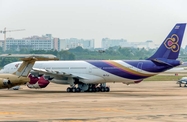The government in Thailand has strongly reiterated its commitment to an ambitious Bt2trn-plus ($60bn) transport system investment plan. The massive programme of spending would focus on rail, urban rapid transit and ports, and the government asserts that it would strongly enhance Thailand’s competitiveness in trade and investment, helping the country make up lost ground.
Speaking at the end of July, transport minister Chadchat Sittipunt made a speech attempting to rally Thailand’s disparate major political parties behind the plan, which was unveiled earlier this year. Specific projects include four new high-speed rail lines, the electrification and double-tracking of railways countrywide, new metro rapid transit (MRT) lines for Bangkok, enhancing ports and constructing new motorways. The government is expected to approve the plan in the next few months, and then will seek loans to finance the investments.
According to Chadchat, the investments would help Thailand make up for a “lost decade” in which infrastructure development has been held back by repeated changes of government (including one coup), general political stability and flooding – all contributing to an economic loss estimated at Bt1.7trn ($50bn).
Local press reports argued that the minister was understating the extent to which Thailand’s transportation network lags behind regional leaders such as China and Malaysia. As Chadchat pointed out, while Thailand ranks fairly well internationally for its transport infrastructure competitiveness at 49th in the world, according to the World Economic Forum, it is behind Singapore (2nd), Taiwan (27th) and Malaysia (29th). It has slipped down the global rankings in recent years on the competitiveness of its roads, railways, airports and ports.
Thai journalist Voranai Vanijaka gave the examples of Lat Krabang Port and Bangkok’s Suvarnabhumi Airport as major projects that took decades to implement and complete; there is also the proposed high-speed rail link between Bangkok and Rayong, on which construction has not started 19 years after it was announced, and the slow work of double-tracking. The lengthy process of official decision-making, exacerbated by regular changes of government, have been blamed.
The minister acknowledged that the transport plan arouses strong opinions in Thailand, with most of the government supportive, but some very much opposed. But he argued that, with regional economic cooperation increasing and competition for investment on the rise, Thailand needs to improve its links to other countries in the region, as well as its internal transportation system. He said that the planned ASEAN Economic Community, which is due to be introduced in 2015, would provide great opportunities for Thailand, but also the possibility that investors will go elsewhere in the region if they deem Thailand to be less attractive.
When the plan was originally announced, Chadchat said that it would help Thailand fulfill its potential as a transportation and logistics centre for the region, as well as stimulate development outside Bangkok. Thailand is included in several regional development and transit corridors, including the Southern Economic Corridor (from Bangkok to Phnom Penh in Cambodia and Ho Chi Minh City in Vietnam) and the North-South Economic Corridor (linking Thailand with Laos, Myanmar and China, and terminating in the Chinese city of Kunming).
The development of railways, generally seen as a greener and cheaper form of transportation than roads, could both lower transportation costs for Thai exporters, as well as regional trade passing through the country, which is located at the heart of South-east Asia. Chadchat asserts that freight train speeds could rise to 60 kph from 39 kph now, and those of passenger trains to 100 kph from 60 kph. These improvements, combined with investments in MRT, should help take pressure off Thailand’s roads. Connectivity to other modes of transport, including airports, ports and roads, will also be enhanced.
The development of regional airports should similarly ease the burden on Suvarnabhumi, which handles more than two-thirds of airport arrivals. Two budget carriers have already moved their bases to the Don Muang Airport, while regional airports grow busier; passenger traffic at Suvarnabhumi fell 6.31% in the first half of 2013 year-on-year, but at the country’s six major airports as a whole, including Suvarnabhumi, it rose 18%, driven by the rise of low-cost airlines and growing tourist arrivals.
Thailand’s transport plans are undoubtedly ambitious, and the country could do more to capitalise on its geographical location and growing position as an investor and exporter across the region. But as critics have pointed out, the country has not always been swift and efficient in executing major projects. Furthermore, the transportation plan does not come cheap, and with investors recently less bullish about emerging market debt, financing may be more difficult to find.

